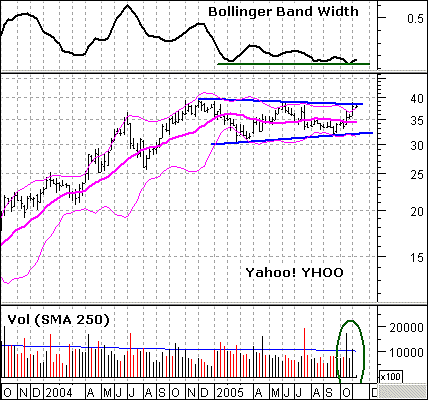
HOT TOPICS LIST
- MACD
- Fibonacci
- RSI
- Gann
- ADXR
- Stochastics
- Volume
- Triangles
- Futures
- Cycles
- Volatility
- ZIGZAG
- MESA
- Retracement
- Aroon
INDICATORS LIST
LIST OF TOPICS
PRINT THIS ARTICLE
by Arthur Hill
Yahoo! has been in a trading range the entire year, but narrowing Bollinger Bands suggest that this situation is about to end.
Position: Accumulate
Arthur Hill
Arthur Hill is currently editor of TDTrader.com, a website specializing in trading strategies, sector/industry specific breadth stats and overall technical analysis. He passed the Society of Technical Analysts (STA London) diploma exam with distinction is a Certified Financial Technician (CFTe). Prior to TD Trader, he was the Chief Technical Analyst for Stockcharts.com and the main contributor to the ChartSchool.
PRINT THIS ARTICLE
BOLLINGER BANDS
Bands Narrow On Yahoo!
11/08/05 01:11:39 PMby Arthur Hill
Yahoo! has been in a trading range the entire year, but narrowing Bollinger Bands suggest that this situation is about to end.
Position: Accumulate
| Bollinger Bands are based on volatility and trend. The center band is a 20-day simple moving average (SMA), providing the trend-following portion of the indicator. The upper and lower bands are placed 2.5 standard deviations above and below the 20-day SMA, providing the volatility portion. Moving averages flatten during trading ranges and volatility usually contracts. This is exactly what is happening to Yahoo! and these indications usually precede a breakout. |

|
| FIGURE 1: WEEKLY YAHOO! The narrowing of the Bollinger Bands reflects the current trading range. |
| Graphic provided by: MetaStock. |
| Graphic provided by: MS QuoteCenter. |
| |
| In October, Bollinger Band width dipped to its lowest level this year (Figure 1). This is a weekly chart, and the narrowing of the bands reflects the current trading range, which looks like a symmetrical triangle. In addition, notice that the upper and lower trendlines are converging, and this furthers the decreasing volatility argument. Symmetrical triangles are neutral patterns that require a breakout for a directional bias. A move above the upper trendline would be bullish and a move below the lower trendline would be bearish. |
| After a high-volume surge the last few weeks (green oval), YHOO is challenging the upper trendline and poised to break out. In addition, the stock moved above the upper Bollinger Band for the first time since May. The move has power, but the stock has yet to break the trendline or the May highs. Further strength above 40 would clear both the trendline and the May high. This would forge a 52-week high and open the door to further gains. |
Arthur Hill is currently editor of TDTrader.com, a website specializing in trading strategies, sector/industry specific breadth stats and overall technical analysis. He passed the Society of Technical Analysts (STA London) diploma exam with distinction is a Certified Financial Technician (CFTe). Prior to TD Trader, he was the Chief Technical Analyst for Stockcharts.com and the main contributor to the ChartSchool.
| Title: | Editor |
| Company: | TDTrader.com |
| Address: | Willem Geetsstraat 17 |
| Mechelen, B2800 | |
| Phone # for sales: | 3215345465 |
| Website: | www.tdtrader.com |
| E-mail address: | arthurh@tdtrader.com |
Traders' Resource Links | |
| TDTrader.com has not added any product or service information to TRADERS' RESOURCE. | |
Click here for more information about our publications!
Comments
Date: 11/08/05Rank: 5Comment:
Date: 11/09/05Rank: 4Comment:
Date: 11/15/05Rank: 4Comment:

Request Information From Our Sponsors
- VectorVest, Inc.
- Executive Premier Workshop
- One-Day Options Course
- OptionsPro
- Retirement Income Workshop
- Sure-Fire Trading Systems (VectorVest, Inc.)
- Trading as a Business Workshop
- VectorVest 7 EOD
- VectorVest 7 RealTime/IntraDay
- VectorVest AutoTester
- VectorVest Educational Services
- VectorVest OnLine
- VectorVest Options Analyzer
- VectorVest ProGraphics v6.0
- VectorVest ProTrader 7
- VectorVest RealTime Derby Tool
- VectorVest Simulator
- VectorVest Variator
- VectorVest Watchdog
- StockCharts.com, Inc.
- Candle Patterns
- Candlestick Charting Explained
- Intermarket Technical Analysis
- John Murphy on Chart Analysis
- John Murphy's Chart Pattern Recognition
- John Murphy's Market Message
- MurphyExplainsMarketAnalysis-Intermarket Analysis
- MurphyExplainsMarketAnalysis-Visual Analysis
- StockCharts.com
- Technical Analysis of the Financial Markets
- The Visual Investor
